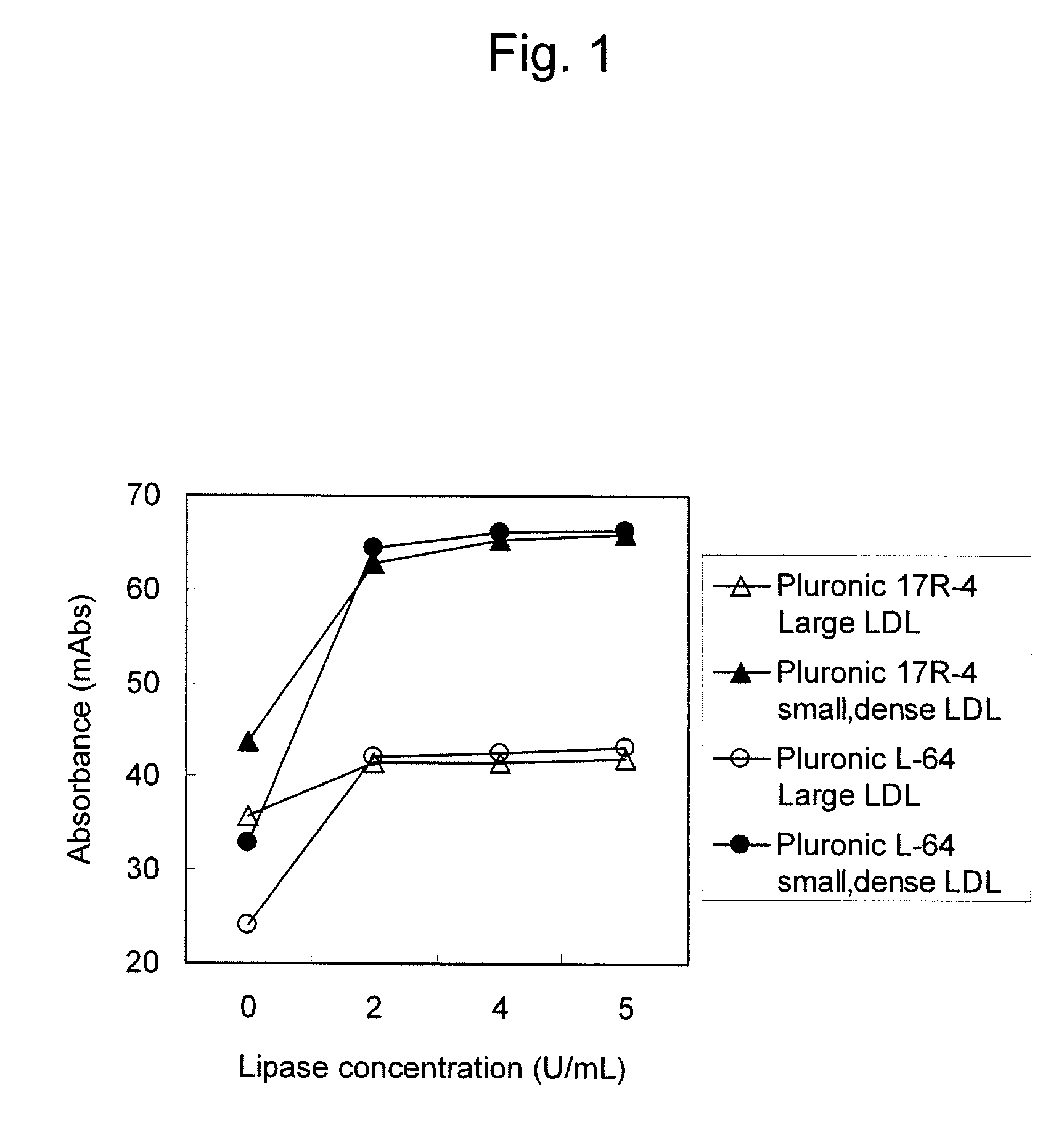Method and kit for quantitative determination for small, dense particle low density lipoproteins
a technology of dense particle and quantitative determination, applied in the field of method and reagent for measuring cholesterol in small, dense lipoproteins, can solve the problems of insufficient specificity and accuracy, inconvenient methods,
- Summary
- Abstract
- Description
- Claims
- Application Information
AI Technical Summary
Benefits of technology
Problems solved by technology
Method used
Image
Examples
example 1
[0058]The following reagent compositions were prepared such that various polyoxyethylene-polyoxypropylene copolymers were used in a second reagent composition.
First reagent compositionPIPES buffer solution, pH 7.050mmol / LCholesterol esterase0.6U / mLCholesterol oxidase0.5U / mLCatalase600U / mLBovine serum albumin0.5%TOOS2.0mmol / L
Second reagent compositionPIPES buffer solution, pH 7.050mmol / LPolyoxyethylene-polyoxypropylene copolymer 0.3%4-aminoantipyrine4.0mmol / LPeroxidase4.0unit / mLSodium azide0.05%
[0059]Thirty human serum samples were used as test samples.
[0060]300 μL of the 1st reagent composition was added to 4 μL of a serum sample, followed by 5 minutes of reaction at 37° C. 100 μL of the 2nd reagent composition was added and then reaction was performed for 5 minutes. Absorbance at 600 nm was measured.
[0061]A “SEIKEN” sd LDL-C reagent kit for measurement of small, dense LDL cholesterol (produced by DENKA SEIKEN Co., Ltd.) was used as a control for comparison, small, dense LDL cholest...
example 2
[0063]The following reaction compositions were prepared such that the 2nd reagent composition of Example 1 was further supplemented with a nonionic surfactant.
1st reagent compositionPIPES buffer solution, pH 7.050mmol / LCholesterol esterase0.6U / mLCholesterol oxidase0.5U / mLCatalase600U / mLBovine serum albumin0.5%TOOS2.0mmol / L
2nd reagent compositionPIPES buffer solution, pH 7.050mmol / LPolyoxyethylene-polyoxypropylene copolymer0.3%Polyoxyethylene nonylphenolether 1%Emulgen 909 [produced by Kao Corporation]4-aminoantipyrine4.0mmol / LPeroxidase4.0unit / mLSodium azide0.05%
[0064]300 μL of the 1st reagent composition was added to 4 μL each of small, dense LDL fractions each with a cholesterol content of 100 mg / dL and large LDL fractions each with a cholesterol content of 100 mg / dL, which had been separated by an ultracentrifugation method, followed by 5 minutes of reaction at 37° C. 100 μL of the 2nd reagent composition was added and then the reaction was performed for 5 minutes. Absorbance a...
example 3
[0068]Thirty human serum samples as test samples were subjected to measurement using the reagent compositions used in Example 2.
[0069]300 μL of the 1st reagent composition was added to 4 μL of a serum sample, followed by 5 minutes of reaction at 37° C. 100 μL of the 2nd reagent composition was added and then the reaction was performed for 5 minutes. Absorbance at 600 nm was then measured.
[0070]Small, dense LDL cholesterol concentrations were compared by linear regression analysis using a “SEIKEN” sd LDL-C reagent kit (produced by DENKA SEIKEN Co., Ltd.) for measurement of small, dense LDL cholesterol as a control for comparison. Table 2 shows the results. Table 2 is the list of correlation coefficients between the products of the present invention obtained with the use of various polyoxyethylene-polyoxypropylene copolymers and nonionic surfactants and the “SEIKEN” sd LDL-C reagent kit for measurement of small, dense LDL cholesterol.
[0071]As shown in Table 2, measurement values obtai...
PUM
| Property | Measurement | Unit |
|---|---|---|
| particle diameters | aaaaa | aaaaa |
| particle diameters | aaaaa | aaaaa |
| particle diameters | aaaaa | aaaaa |
Abstract
Description
Claims
Application Information
 Login to View More
Login to View More - R&D
- Intellectual Property
- Life Sciences
- Materials
- Tech Scout
- Unparalleled Data Quality
- Higher Quality Content
- 60% Fewer Hallucinations
Browse by: Latest US Patents, China's latest patents, Technical Efficacy Thesaurus, Application Domain, Technology Topic, Popular Technical Reports.
© 2025 PatSnap. All rights reserved.Legal|Privacy policy|Modern Slavery Act Transparency Statement|Sitemap|About US| Contact US: help@patsnap.com


